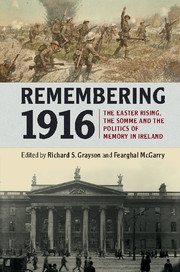Book contents
- Frontmatter
- Contents
- List of figures
- List of tables
- List of contributors
- Introduction
- Part I Memory and commemoration
- Part II Narratives
- Part III Literary and material cultures
- 8 The Rising generation and the memory of 1798
- 9 Cultural representations of 1916
- 10 Myth, memory and material culture: remembering 1916 at the Ulster Museum
- Part IV Troubled memories
- Index
9 - Cultural representations of 1916
from Part III - Literary and material cultures
Published online by Cambridge University Press: 05 March 2016
- Frontmatter
- Contents
- List of figures
- List of tables
- List of contributors
- Introduction
- Part I Memory and commemoration
- Part II Narratives
- Part III Literary and material cultures
- 8 The Rising generation and the memory of 1798
- 9 Cultural representations of 1916
- 10 Myth, memory and material culture: remembering 1916 at the Ulster Museum
- Part IV Troubled memories
- Index
Summary
If from a cultural perspective the idea of 1916 has continuing meaning for contemporary Ireland, it is to provoke critical reflection on the evolving and interconnected processes of aesthetic and historical transformation that act upon it. For some decades now, the cultural history of Ireland has been the subject of sophisticated literary analysis, with more sporadic attention given to the visual arts and music. This history has remained largely the site of established narratives of cause and effect, which have been shaped in turn by ideas of nation and state that have undergone little renovation, for all the more recent turn away from the canonical figures of high politics towards micro-studies of place and community. Recently, a shift towards memory and the transnational as theoretical terms of engagement has brought history closer to a literary study that understands Ireland and its culture as one part of a globally complex equation. To think of the cultural representation of 1916 is to ask questions of production and reception in a twentieth- and twenty-first-century Ireland that continues to be the contested site of far-reaching processes, in empire and after.
Evidence for this registers in the resurgence of 1916 as a public point of interest at key moments in political history. The Easter Rising has not been a constant cause for celebration in the hundred years since its occurrence. The fact of its centenary should not obscure the variable pull of its significance on the public consciousness, and as Anne Dolan has remarked, the civil war lingers still like Banquo's ghost at the commemoration feast. The cultural representation of 1916 north of the border is another matter altogether, given the synthesis of the Somme with particular kinds of unionist identity. There, sacrifice on the Western Front is significant of Ulster's loyalty to the crown, a split history that is inaccurate, partial and significant mostly of subsequent conditions of twentieth-century Ireland, namely partition and violence.
These realities have their common core in the island of Ireland's deep experience of empire. Britain entered a new phase of global hegemony in the nineteenth century. British power was military and commercial, and the cultural effects of this combination registered in Dublin as home to a thriving music hall and cinema culture that integrated popular entertainment with sophisticated synergies of image, music and text.
- Type
- Chapter
- Information
- Remembering 1916The Easter Rising, the Somme and the Politics of Memory in Ireland, pp. 168 - 180Publisher: Cambridge University PressPrint publication year: 2016
- 1
- Cited by

